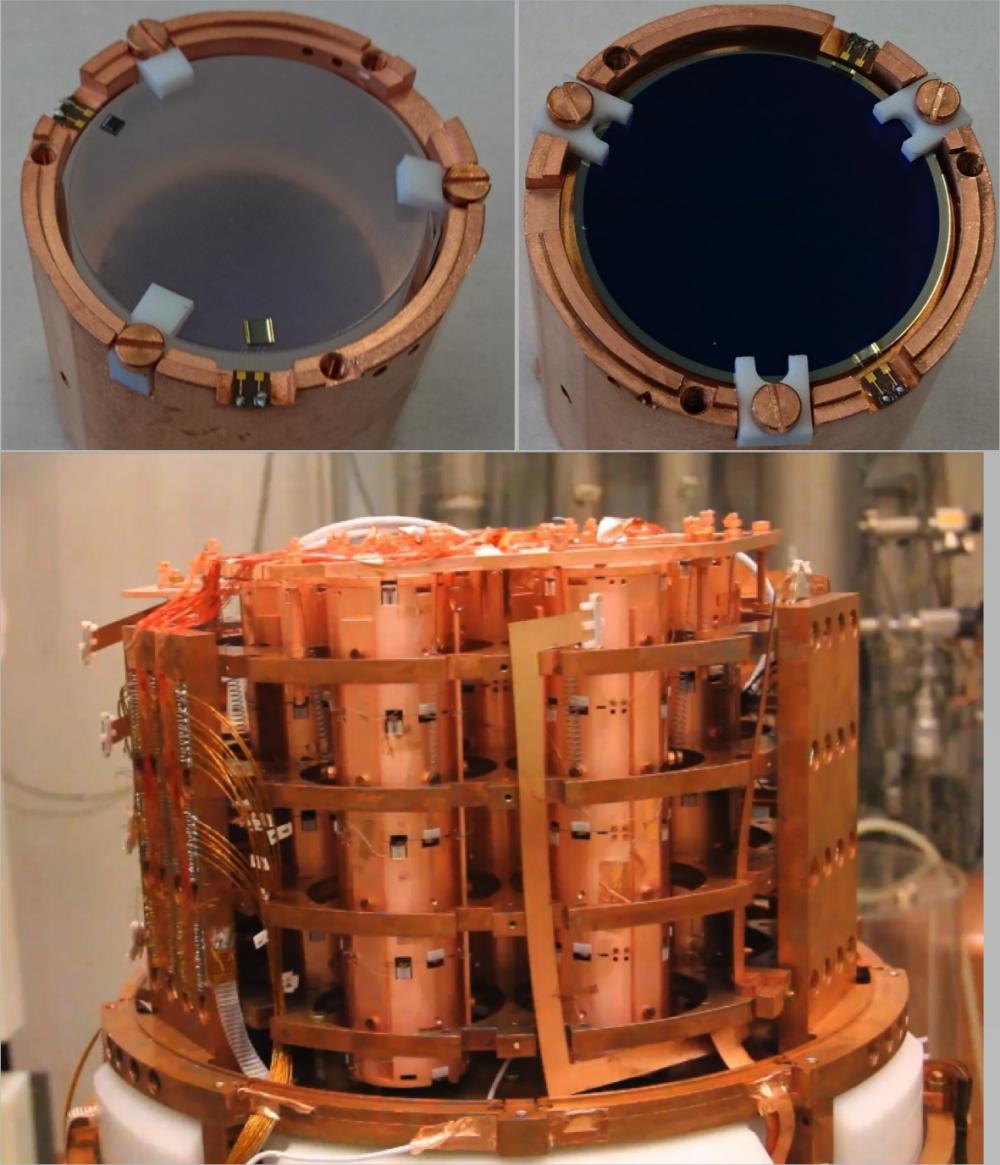
top – picture of one enriched Li2MoO4 crystal coupled to its Ge light detector
bottom : picture of the CUPID-Mo detector installed inside the EDELWEISS cryostat at LSM
In its standard form, double beta decay is a process in which a nucleus decays into a different nucleus and emits two electrons and two antineutrinos (2νββ). This nuclear transition is very rare, but it was detected in several nuclei with sophisticated experiments. If neutrinos are their own antiparticles, it’s possible that the antineutrinos emitted during double beta decay annihilate one another and disappear. This is called neutrinoless double beta decay (0νββ), a phenomenon never observed so far. If 0νββ is detected, we will ascertain that neutrinos are their own antiparticles, and this would be a clue as to why they get their tiny masses—and whether they played a part in the existence of our matter-dominated universe.
The CUPID-Mo experiment, installed at the Modane Underground Laboratory, after one year of data between March 2019 and April 2020 has just set a new global limit for the detection of the signature 0νββ.
Observation of 0νββ is a major challenge: Scientists need to find single events in a ton × year of exposure.
Neutrinoless double beta decay radioactivity corresponds to less than 10-13 Bq/g, while in normal life we are confronted with 15 Bq/banana! On the one hand, 0νββ is an extremely rare process, but on the other hand its signature is extremely clear and unambiguous: scientists need to find just a peak in the spectrum of the total energy deposited in the detector by the two emitted electrons. The expected position of the peak is known with better than 0.1% accuracy.
The keywords in 0νββ search are:
The CUPID-Mo experiment, currently taking data at the Laboratoire Souterrain de Modane (France), is a demonstrator for CUPID, the next-generation upgrade of the first ton-scale cryogenic 0νββ-search, CUORE. CUPID-Mo is searching for 0νββ decay of 100Mo with an array of 20 enriched ~0.2 kg Li2MoO4 crystals corresponding to 2.264 kg of 100Mo. The CUPID-Mo collaboration managed to combine the scintillating bolometer technique with an appropriate choice of the nucleus and of the crystal to obtain the exceptional background noise rejection necessary to study 0νββ of 100Mo with unprecedented sensitivity.

In this present analysis, we consider more than one year of data (2.17 kg × y of exposure) acquired between March 2019 and April 2020. Due to an efficient duty cycle, an excellent analysis efficiency of ~ 90% and especially zero background in the region of interest, we can set a new world leading limit for 0νββ decay of 100Mo of 1.4x1024 y, significantly better than the previous 1.1x1024 y, obtained by the NEMO3 collaboration, also at Modane.
Thanks to a very efficient alpha-to-beta/gamma separation and excellent radio-purity levels, we obtain preliminary estimates of remaining backgrounds significantly below the 10-2 counts/(keV kg year) level in the 0νββ region of interest (around 3034 keV for 100Mo) and are hence able to operate in the background free regime for the 0νββ analysis of CUPID-Mo. This background level is already significantly better than that achieved in the leading bolometric experiment CUORE in the region of interest.
Now, an improved energy calibration of the experiment is ongoing, and several physics analyses will be performed in the coming months, along with a refined study of the background model.
Later this decade, the CUPID-Mo technology will be pursued on a large scale in the CUPID experiment, with about 1500 crystals installed at the Gran Sasso Laboratory in Italy in the current CUORE facility. CUPID will be at the forefront of 0νββ search.
|
The CUPID-Mo experiment brings together several French laboratories— Irfu/CEA, JCLab (Orsay), IP2I (Lyon), Institut Néel and SIMaP (Grenoble) — and other international laboratories (USA, Ukraine, Russia, Italy, China and Germany). |
En savoir plus:
CUPID-Mo: a new limit on neutrinoless double beta decay of 100Mo
• The ultimate constituents of matter › Neutrino Physics
• Institute of Research into the Fundamental Laws of the Universe • The Electronics, Detectors and Computing Division • The Particle Physics Division
• Sources and reactors neutrinos
• LUMINEU
